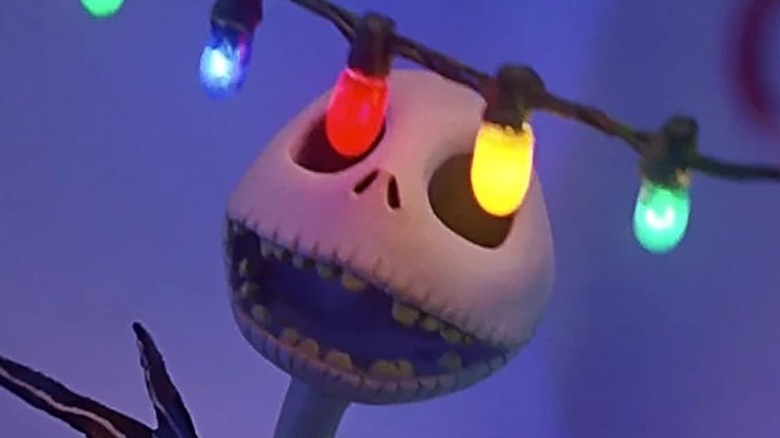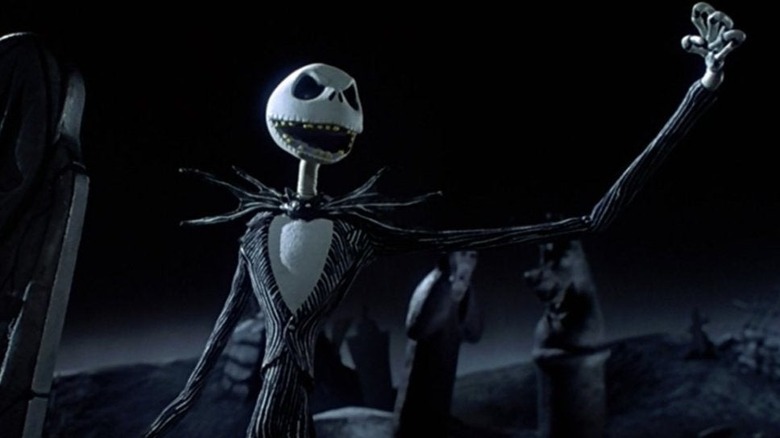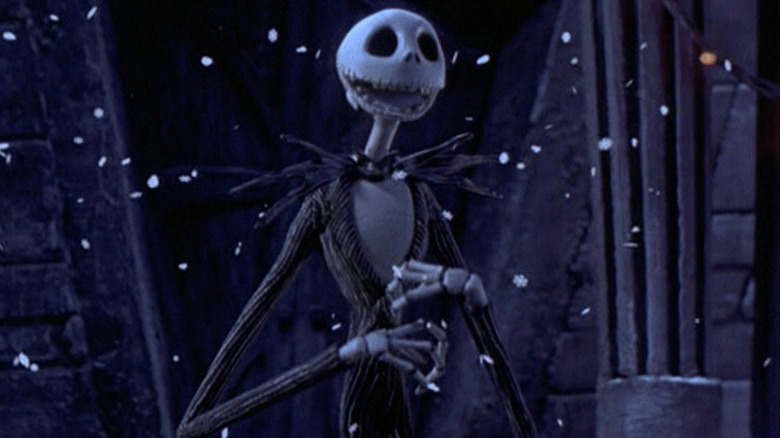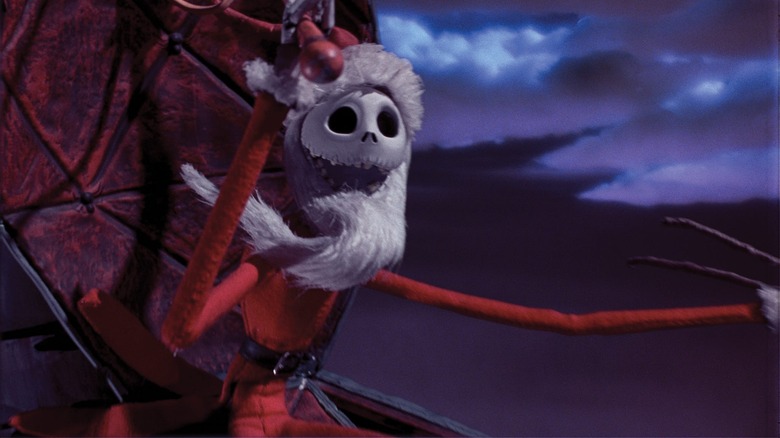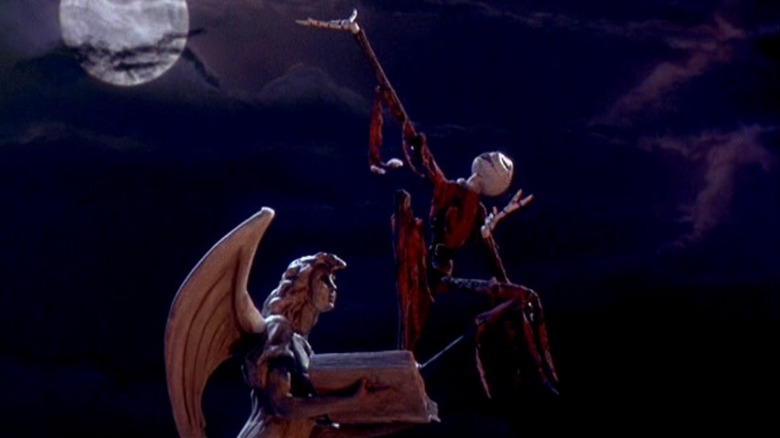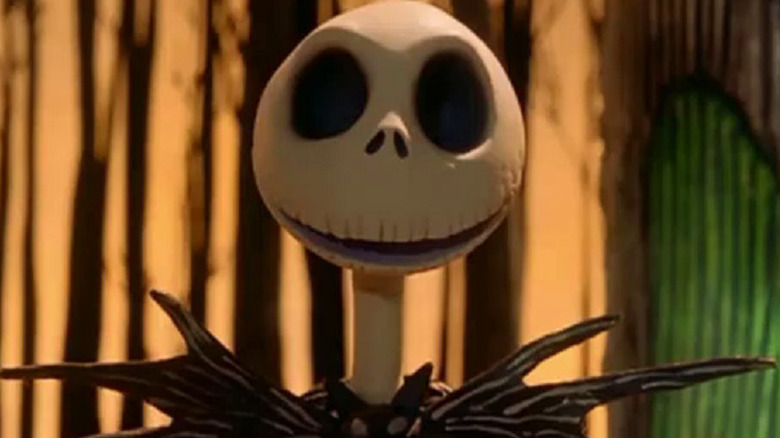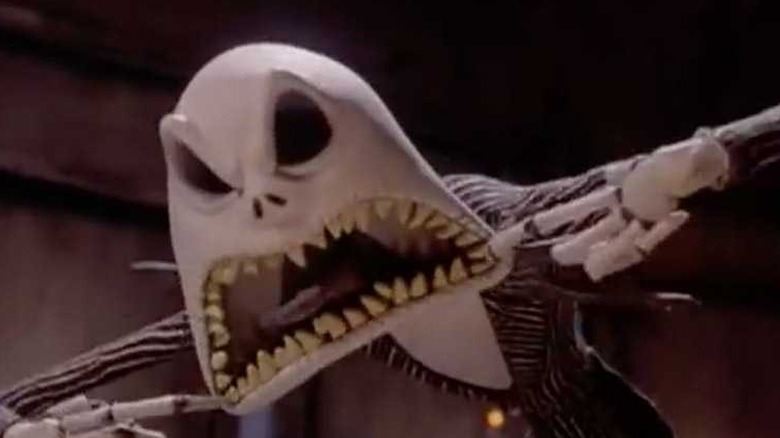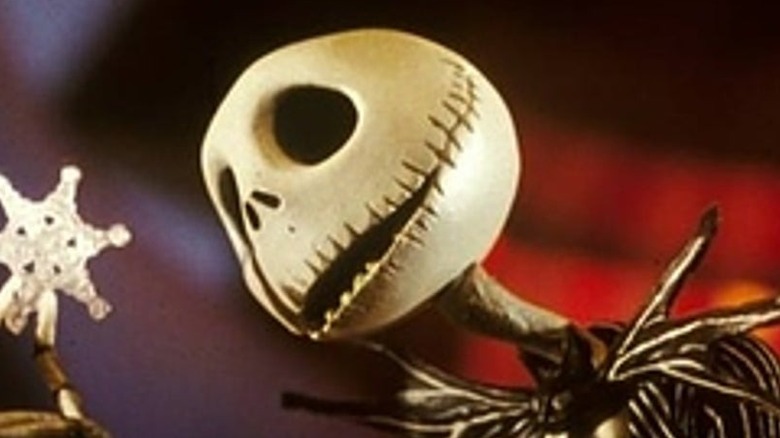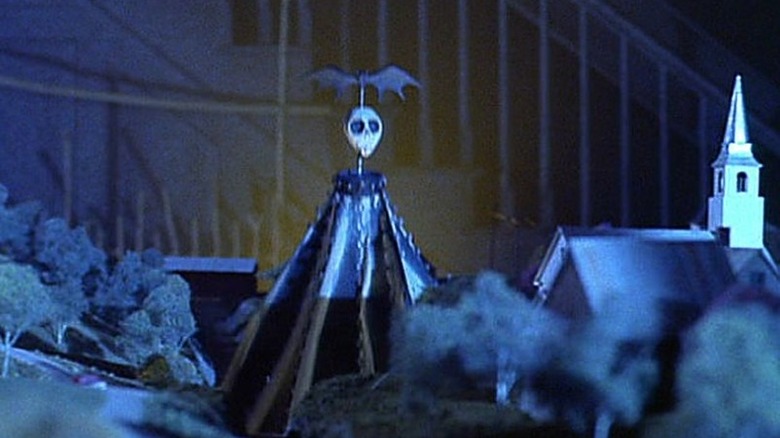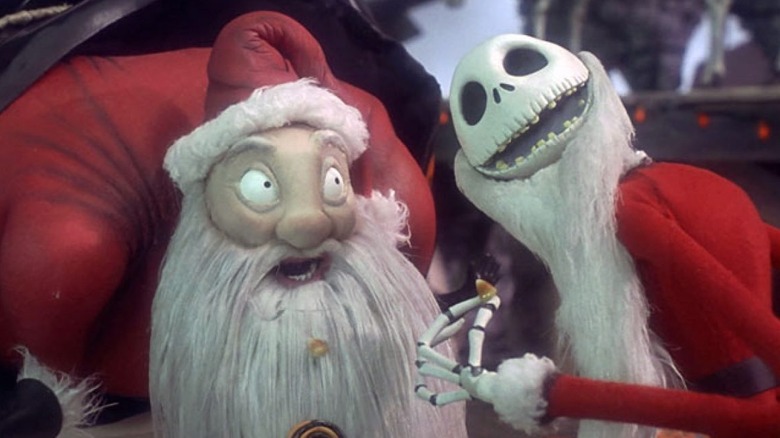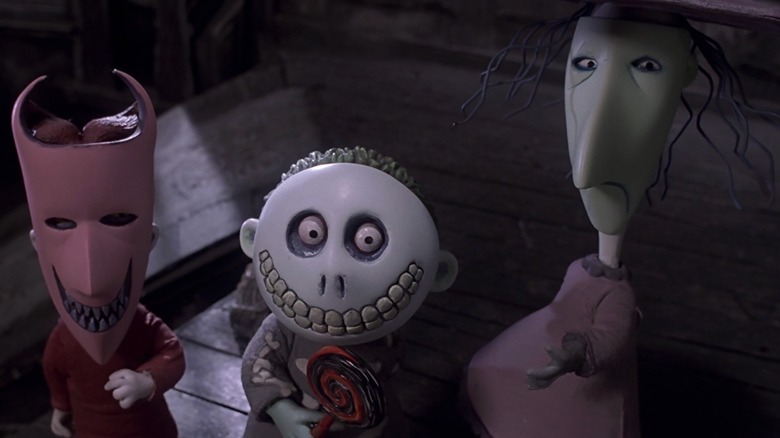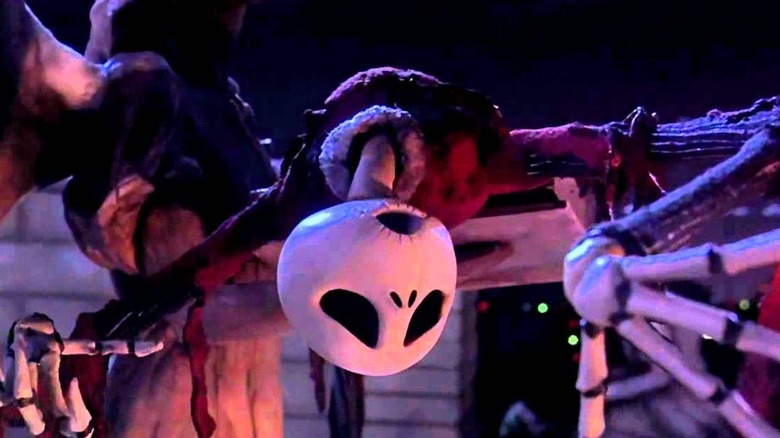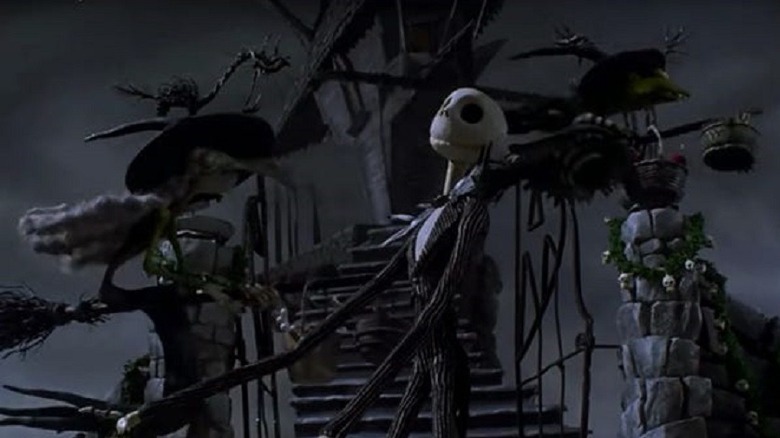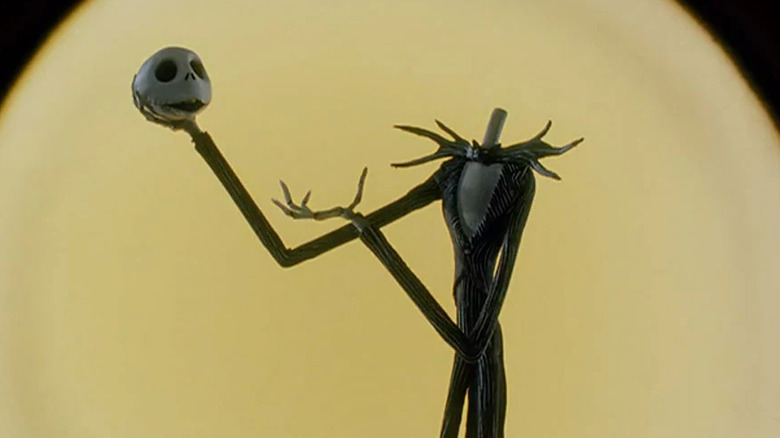Things Only Adults Notice About Jack Skellington
In 1982, Tim Burton, then a Disney illustrator and now a director known for his unconventional stories and gothic aesthetic, wrote a poem that put a twist on a Christmas classic. His original poem, "The Nightmare Before Christmas," is a stripped-down version of the movie Disney would eventually produce, but all the bones (pun intended) are there. Including, of course, Jack Skellington at the center of it all.
Jack Skellington is the Pumpkin King — the mascot, inspiration, and frightener-in-charge for Halloween Town. Despite being the best at what he does, Jack's ennui at living a life solely dedicated to Halloween frights takes him on an adventure to Christmas Town, where he discovers the "more" he's looking for. So goes the stop-motion classic that manages to single-handedly combine the opening and closing feasts of the end-of-year holiday season.
At first glance, Skellington just seems like a bored ruler looking to change things up. Yet everything you notice about him as an adult — all the little details a kid might miss — help make him into the enigmatic, nature-defying, complicated, and frighteningly endearing skeleton man we all know and love.
Jack is a political figurehead
Jack Skellington is called the Pumpkin King, but really, what does that title mean in real-world terms? Jack isn't a monarchic leader. And Halloween Town already has a political leader — its two-faced mayor. Sure, Skellington helps organize the spooking and scaring that takes place on Halloween and gives some great speeches, but it's tough to say what exactly he does for an actual job.
So he's a leader who holds no real political power, is skilled at motivating and inspiring, and is beloved by everyone? He's also a consultant to the powers-that-be, yet it's hard to put one's finger on what exactly he does for a "real" job? Strange, that sounds so familiar: It's like the Royal Family of England. Jack truly is royalty as his title implies, and his status is complete with the ennui that goes along with a position that calls mostly for image-making and consulting. No wonder he's jealous of the hardworking, much-credited Santa Claus. At least Santa is more than a figurehead and actually gets things done.
He has joints in his fingers but not his neck
In an animated movie, nearly every detail is drawn on purpose — especially in a movie where everything is created from scratch and produced by a man known for crafting a very specific, detailed look for his films. In "Nightmare Before Christmas" Jack Skellington's hands show the joints between his knuckles, which makes sense — the emphatic leader is big on hand gestures and physical articulation. But if he needs joints to move his fingers, how does he move his neck? It looks like one single fused bone rather than a stack of vertebrae. It has wrinkles, but that's about it.
Jack is truly an enigma, a fact we'll explore more throughout this article. But simply based on how skeletons work — specifically how bones don't move and bend themselves but instead achieve mobility through the combined efforts of their muscles and joints — Jack's neck couldn't bend, twist, and turn without vertebrae. How does the ever-introspective Jack bend his neck in contemplation and wonderment, then? Such deep questions, hard-hitting and poignant, may never be answered.
It looks physically impossible to get into his clothes
Jack's always wearing his trademark suit. How does he get it on? Even more importantly, how does Jack manage his wardrobe change? When he decides to usurp Santa Claus' job, he puts on his own red and white, super-tight Santa suit. Anybody who's tried to squeeze themselves into an outfit that's far too small has to wonder how he gets dressed.
Jack's arms are almost twice the length of his torso, and since the movie does show his arms following the basic anatomical rules that the humerus, radius and ulna can't bend, it would seem impossible for him to get both arms into and out of the jacket especially. The bone-thin pants wouldn't be able to slip over his feet easily either, regardless of how scrawny they are. While it does seem possible that Sally just sewed it onto him, the fact that she pricks his hand while sewing on the cuffs (as an aside, it's weird that he reacted to this "injury" given his lack of flesh and nerve-endings) leads us to believe that this wouldn't be his first-choice method of getting dressed.
Maybe his bone, weathered by years of the afterlife, is smoother and offers less frictional resistance than human skin would, allowing him to easily slip into uncomfortable outfits.
Jack's suit is his skin
Jack's black-and-white suit looks like it's glued on — which it would have to be, considering the difficulty that someone of Jack's proportions would encounter, as we discussed, when taking clothes on and off. Even more, when Jack's Santa suit is blown up by the military after he gives a bunch of kids demonic toys and severed body parts for Christmas, it's revealed he was "wearing" his pinstripe suit under the Santa suit the whole time. Therefore, it would seem Jack never takes his suit off — and we don't know if he actually can.
If he can't, that would make sense for more than just aesthetic reasons. Getting back to the fact that Jack is a skeleton, and skeletons are held together not in and of themselves but by soft tissue that eventually rots away, theoretically he should just fall apart.
Obviously, there's already a lot of suspension of disbelief that needs to occur in order to accept most of what we see in Halloween Town. Yet it would make sense that Jack's suit, given how tight it is, also serves the purpose of keeping his bones together, just like skin keeps our insides from falling out. Therefore Jack Skellington, like some sort of bipedal zebra, for all intents and purposes has black-and-white pinstriped skin.
Jack has no eyes
Disney had some serious apprehensions about "The Nightmare Before Christmas" as a children's movie. Their concerns about the horror elements led Disney to release the film under the company's "grown-up" subsidiary, Touchstone Pictures, instead of the main label. The entertainment giant also requested some changes, one very notable: that Jack Skellington get eyes put into his empty sockets.
They say the eyes are the windows to the soul, a fountain of emotion that allows people to relate to each other, so perhaps Disney was worried that Jack would seem lacking in personality without them. Or perhaps the studio was worried that Jack Skellington would look too sinister for younger audiences. Luckily, producer-creator Tim Burton and director Henry Selick stood their ground on the point that Jack is, in fact, a skeleton, and skeletons don't feature any organic material, including eyes.
It's a good thing they stood so strong, because Jack is now a beloved character overflowing with emotion, even if you can't glimpse his soul through his two big, empty sockets. Kids might not even notice that he has no eyes, because his face is still extremely expressive, but adults will.
Jack's skull can change shape despite being bone
Of course, people (using that term loosely with Jack) emote with more than just their eyes. A fair bit of emotion comes across in the eyebrows. If they're slanted down toward the nose making a "V," that person looks angry. If they slant the opposite way, that person looks sad. Even easier to read than the eyebrows is the upward or downward tilt of the lips to signal positive or negative emotions, respectively. Without eyes, Jack has to depend even more on these facial reactions, and his physical expressions are incredibly effective in "The Nightmare Before Christmas." The only problem with this is that a skull doesn't actually have the ability to move.
Muscles and skin create the appearance of brows going up or down, as well as contorting the lips into a smile or a grimace. The human skull doesn't move in real life, since bone is solid. Certainly there has to be some artistic license at play to give a skeleton without eyes some semblance of emotion. The animators afford Jack's skeletal face the same flexibility he'd have if it were covered in skin. It's almost as if Jack Skellington's skull is made of clay or something.
Jack's stitches serve the function of muscles
There are obviously some weird anatomical things going on with Jack Skellington. We've already discussed his lack of neck vertebrae and his emotive skull, but there's one more thing that soon draws a critical eye: His mouth is stitched together ... except when it's not. The lines running up and down his face at first could be seen simply as stylized wrinkly lips — maybe remnants of flesh in a state of decay.
But if you look toward the back of Jack's skull, his mouth looks like it's just sewn together. When you think about it, this makes sense: There are no muscles to hold the bottom and top of his jaw in place. When closed, the mouth looks like it's eternally strung together. When open, it's as if the threads have magically split, except towards the back, where they hold the hinges of the jaw in the absence of the muscles that would normally serve that function. So we'll add another unique feature to Jack's anatomy: String can be sewn through bone and take the place of muscles and tendons.
Jack Skellington is truly a medical marvel.
He looks like a model in Beetlejuice
While he wrote the delightfully creepy poem "The Nightmare Before Christmas" all the way back in 1982, the first Hollywood feature film to highlight Tim Burton's trademark aesthetic wouldn't come until "Beetlejuice" in 1988. ("Pee-wee's Big Adventure" came first, but "Beetlejuice" is the first film where his unique spooky aesthetic took center stage.)
A lot of little details in "Beetlejuice" seem very similar to elements of "Nightmare Before Christmas." When Geena Davis and Alec Baldwin are brought back in the séance, their faces have the same distinct, wrinkly lines seen on the faces of the deceased in Halloween Town. Beetlejuice uses games as a way to torture the people, similar to Oogie Boogie's antagonism of Jack Skellington and Santa Claus. The statues coming to life in "Beetlejuice" are echoed by the kids' walking bathtub in "Nightmare." Finally, a ghostly hat decoration in "Beetlejuice" looks eerily similar to Jack Skellington.
When Beetlejuice finally gets to have his fun and haunt the humans (after Lydia calls on him by saying his name 3 times) he appears wearing a distinctive hat. At the top is a man with a hollow-eyed skull in a familiar shape, adorned by a bat looks a lot like Jack's bowtie. This figure is also wearing a black-and-white striped suit like Jack (and Beetlejuice himself). Whether this hat topper is based on Burton's idea for Jack Skellington or the other way around, the resemblance is unmistakable.
Jack's a bit delusional to think he's on par with Santa Claus
Lots of holidays are associated with well-known characters. Easter has the Easter Bunny. Christmas has Santa Claus. Valentine's Day has Cupid. And of course, everybody knows Halloween has Jack Skellington. Wait, what? Who is Jack Skellington? He didn't exist prior to 1982 at the earliest when he showed up in Burton's poem, but many of the other holiday mascots have been around for decades, even centuries.
Halloween is obviously a huge holiday — there are entire stores devoted to it. Yet Jack Skellington, the Pumpkin King whose visage is synonymous with the day of spooky celebration, is a personal — and relatively recent — invention of Tim Burton. One has to raise an eyebrow at the fact that Jack Skellington, a hero of Halloween Town but previously unknown in the real world, thinks he's on the same level as the much-beloved and long-storied Santa Claus.
This comparison is laughable. What an ego; what a pretentious, spooky ghoul. How does Jack think he can slip into shoes Santa has been filling for generations? Such confident delusion is a driving factor of the plot in "Nightmare Before Christmas," and part of what makes Jack seem so, well, human (even if some might also call him naïve for thinking he's on the same level as Santa).
Jack is naïve to trust Lock, Shock, and Barrel
Why does Jack task Lock, Shock, and Barrel with kidnapping the holiday icon he mistakenly refers to as "Sandy Claws"? Even more alarmingly, why does he assume that the kids, also referred to as "Boogie's Boys," wouldn't go right to Oogie Boogie and spill the beans? Seriously, for a character who's apparently so smart that the Mayor needs his guidance on the yearly Halloween plans, why in the name of all that's sacred in Halloween Town would he trust these impish trick-or-treaters?
First off, they're obviously not the sharpest, since they accidentally kidnap the Easter Bunny instead of Santa. Secondly, everybody in Halloween Town loves Jack and holds him in the highest esteem: Surely he could have found an eager and loyal helper anywhere. So why would he instead pick three kids who at best treat him with amused disdain? Finally, again, their established association with Jack's rival Oogie Boogie means they're definitely not to be trusted. Jack even instructs, "Leave that no-account Oogie Boogie out of this," so he knows where their true loyalties lie but decides to count on them anyway. At best he looks naïve and overly trusting; at worst he looks downright stupid.
Jack's pretty invincible for a pile of bones
Jack Skellington is just a collection bones without connective or protective tissue, held together in large part by a suit, possibly with stitches securing his jaws. One wouldn't think that makes for a very durable body. Yet Jack gets hammered by cannon fire and escapes with little more than a burned Santa suit as a result.
Jack jumps around Oogie's projectiles and traps like an evasive cross between a spider and a gymnast. He seems untouchable but really, even if he had been hit, what would have been the result? The Pumpkin King is blasted out of the sky by the military and springs back up almost immediately, even singing a little bit and retaining enough strength and power to return home and save Santa Claus and Sally. Perhaps there's some truth to the idea that you can't die twice. Or maybe Jack is just really, really, un-killable — at the very least, he must drink a lot of milk to fortify those bones.
He's the least colorful Disney protagonist since the black-and-white era
Disney famously entered the entertainment business with "Steamboat Willie," a black-and-white cartoon featuring Mickey Mouse's first appearance as he whistles and spins a steering wheel. Disney went on to produce many more shorts, eventually moving to color with a Silly Symphonies short called "Flowers and Trees." From that point on, Disney took to the Technicolor world with great success. The radiant hues of Disney films have inspired much analysis and art, and Disney apparently even invented a few colors.
Watch every Disney film and try to find a predominantly black-and-white main character since the move to full color. There really isn't one until Jack Skellington (aside from the dogs in "One Hundred and One Dalmatians"). Even in that movie, while the Dalmatians have to be black and white to portray a real-life dog breed, the rest of the world is pretty colorful. Jack Skellington is a black-and-white character by conscious design, in a world that's also very dark and monotone. Thus this is arguably the least colorful Disney film, with the least colorful humanoid main character, since the invention of Technicolor.
Jack echoes a Shakespearean legend
While singing the number "Jack's Lament," Jack removes his head, holding it out like Hamlet holds the exhumed jester Yorick's skull while reciting the famous "Alas, poor Yorick" speech. The fact that Jack is a skeleton and can seemingly bend the rules of anatomy allows him to embody (literally) both Yorick and Hamlet in the recreation of this Shakespearean scene.
While this self-decapitation lasts just for a moment during Jack's sweeping song about identity and futility, it speaks very strongly to who Jack really is. One part of him is Hamlet, full of ennui and self-doubt, wondering at the purpose of his own existence. But another part of him is the jester Yorick, the silly fool who can make you laugh and cry, who can tumble and fall and get back up with a big smile.
In this one moment, Jack shows just how complicated he truly is.
